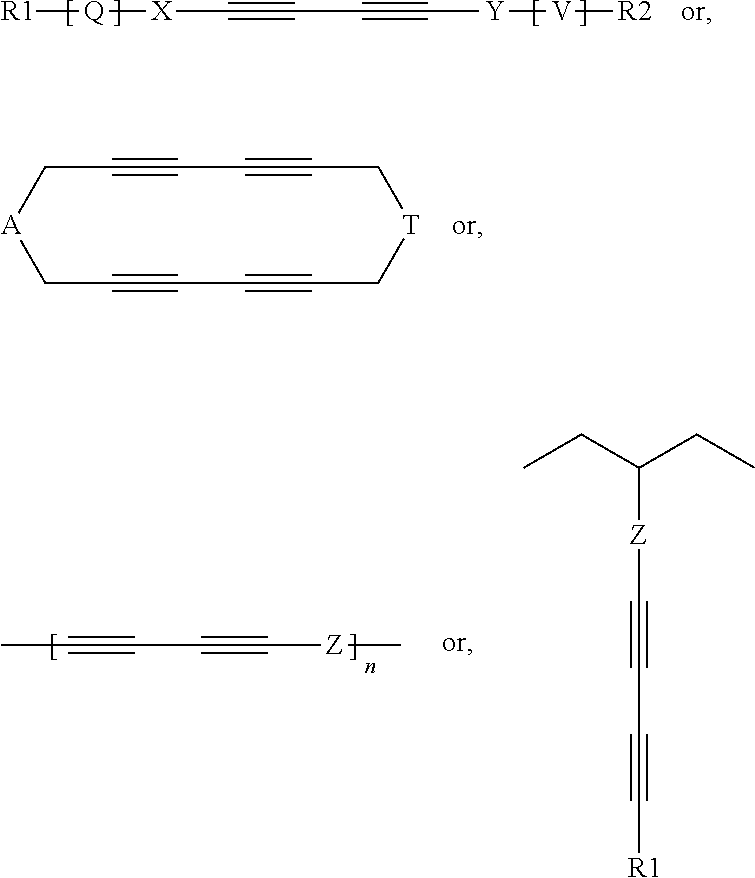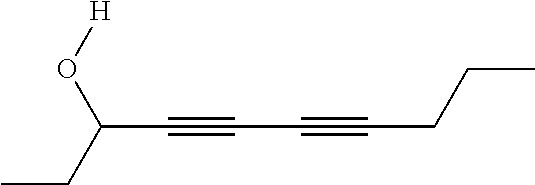Filters
a filter and filter body technology, applied in the field of filters, can solve the problems of time-consuming and expensive techniques
- Summary
- Abstract
- Description
- Claims
- Application Information
AI Technical Summary
Benefits of technology
Problems solved by technology
Method used
Image
Examples
example 1
[0059]a. Carbazole Ink
[0060]N-Ethyl carbazole (ex. Aldrich, 5 g) was dissolved in a 15% solution of nitrocellulose DLX3-5 (ex. Nobel Enterprises) in MEK (95 g).
[0061]Copper (II) triflate (ex. Aldrich, 0.38 g) was then dissolved in the above N-ethyl carbazole / NC solution (9.62 g).
b. Diacetylene Ink
[0062]10,12-Pentacosadiynoic acid (ex. GFS Chemicals, 0.5 g) was dissolved in ethyl acetate (2 g). This solution was then added to Durotak 180-1197 adhesive (ex. Delft National Chemie, Zutphen, Netherlands) and was warmed with shaking into a clear solution.
Ink Application
[0063]The carbazole ink was coated onto 50 micron clear PET film using a 30 micron K-bar and RK-Proofer Printer and dried.
[0064]The diacetylene / Durotak ink was coated onto 50 micron clear biaxially orientated polypropylene using a 30 micron K-bar and RK-Proofer Printer and dried.
[0065]The two coated substrates were pressed together to form a laminate construction.
[0066]A broadband UV germicidal lamp was used to initiate the...
example 2
Single ink
[0070]a. Carbazole Part
[0071]N-Ethyl carbazole (ex. Aldrich, 1 g) was dissolved in a 15% solution of nitrocellulose DLX3-5 (ex. Nobel Enterprises) in MEK (9 g).
[0072]Copper (II) triflate (ex. Aldrich, 0.72 g) was then dissolved in the above N-ethyl carbazole / NC solution (9.38 g).
b. Diacetylene Part
[0073]10,12-Pentacosadiynoic acid (ex. GFS Chemicals, 1 g) was dissolved in a 15% solution of Elvacite 2028 in ethyl acetate (9.0 g).
[0074]The carbazole ink (5 g) and the diacetylene ink (5 g) were then combined to form a single ink.
Ink Application
[0075]The single ink was coated onto clear 50 micron biaxially orientated polypropylene film using a 30 micron K-bar and RK Proofer Printer.
[0076]Durotak 180-1197 adhesive (ex. Delft National Chemie, Zutphen,
[0077]Netherlands, 7.5 g) was dissolved in ethyl acetate 2.5 g.
[0078]The Durotak was coated onto clear 50 micron PET film using a 30 micron K-bar and RK Proofer Printer.
[0079]The two films were combined to produce a laminate constru...
example 3
[0084]a. Diacetylene Ink
[0085]10,12-Pentacosadiynoic acid (1 g), Durotak 180-1197 (19 g) and ethyl acetate (4 g) were mixed together to produce an ink solution.
[0086]The ink was coated onto clear 50 micron biaxially orientated polypropylene film using a 30 micron K-bar and RK Proofer Printer.
b. Leuco Dye Ink
[0087]An ink was formulated comprising: Pergascript Blue SRB-P (ex. Ciba, 1.7 g), Yamada Yellow Y-726 (ex. Yamada 2.8 g), Tinuvin 770DF (0.6 g), Sericol Polyplast PY-383 (ex. Sericol, 56 g), Sericol Thinner ZV-557 (ex. Sericol 35.5 g) and Cyracure UVI Photoinitiator UVI-6992 (ex. Dow, 3.4 g).
[0088]The ink was coated onto clear 50 micron biaxially orientated polypropylene film using a 30 micron K-bar and RK Proofer Printer.
[0089]The two coated BOPP films were combined to form a laminate.
[0090]The diacetylene layer turned colourless to blue and then red on exposure to UV light emitted from a Coherent Avia 266 nm UV laser or a suitable broadband light source, which includes 266 nm r...
PUM
| Property | Measurement | Unit |
|---|---|---|
| Wavelength | aaaaa | aaaaa |
| Wavelength | aaaaa | aaaaa |
| Area | aaaaa | aaaaa |
Abstract
Description
Claims
Application Information
 Login to View More
Login to View More - R&D
- Intellectual Property
- Life Sciences
- Materials
- Tech Scout
- Unparalleled Data Quality
- Higher Quality Content
- 60% Fewer Hallucinations
Browse by: Latest US Patents, China's latest patents, Technical Efficacy Thesaurus, Application Domain, Technology Topic, Popular Technical Reports.
© 2025 PatSnap. All rights reserved.Legal|Privacy policy|Modern Slavery Act Transparency Statement|Sitemap|About US| Contact US: help@patsnap.com



